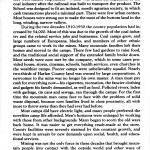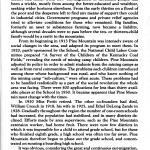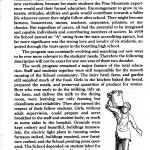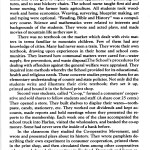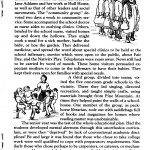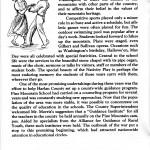Pine Mountain Settlement School
Series 04: Pine Mountain Settlement School Histories
THE PINE MOUNTAIN STORY – CH. III
TAGS: The Pine Mountain Story – Ch. III ; The Boarding School 1930-1949 ; effects of World War I ; railroads ; coal industry ; The Depression ; out-migration ; social revolution ; boarding high school ; Glyn A. Morris ; work program ; classroom activities ; Citizenship Committee ; recreation ; Guidance Institute ;
THE PINE MOUNTAIN STORY – CH. III contains the images and transcription of Chapter III of “The Pine Mountain Story 1913-1980.” This chapter covers “The Boarding High School: 1930-1949.”
The booklet was written and illustrated in 1980 by Mary Rogers. Mary was a PMSS worker for over 50 years and wife of Burton Rogers, director of the School from 1949 to 1973.
For other chapters and more about “The Pine Mountain Story 1913-1980” and the author, Mary Rogers, go to GUIDE TO “THE PINE MOUNTAIN STORY 1913-1980.”
CONTENTS: The Pine Mountain Story – Ch. III
The Boarding School 1930-1949 ; Mary Rogers illustrations ; effects of World War I ; railroads ; coal industry ; population increase ; coal camps ; polluted rivers ; county services ; decreased isolation ; The Depression ; drought ; out-migration ; big families ; adaptation by PMSS ; National Child Labor Committee ; A Survey of the Children of the Kentucky Coal Fields ; social revolution ; phasing out of grade school ; focus on boarding high school ; Glyn A. Morris ; meeting students’ needs ; work program ; student labor ; school counselors ; survey courses ; civic textbooks ; print shop ; consumers’ cooperative ; the Co-operative Movement ; classroom activities ; community group ; community service ; one-room school visits ; packhorse librarian ; senior year assessments ; Citizenship Committee ; Octet ; recreation ; Nativity Play ; operas ; special occasions ; Guidance Institute ; Alliance for Guidance of Rural Youth ;
GALLERY: The Pine Mountain Story – Ch. III
- Mary Rogers: The Pine Mountain Story – Ch. III. [pmss-story011.jpg]
- Mary Rogers: The Pine Mountain Story – Ch. III. [pmss-story012.jpg]
- Mary Rogers: The Pine Mountain Story – Ch. III. [pmss-story013.jpg]
- Mary Rogers: The Pine Mountain Story – Ch. III. [pmss-story014.jpg]
- Mary Rogers: The Pine Mountain Story – Ch. III. [pmss-story015.jpg]
- Mary Rogers: The Pine Mountain Story – Ch. III. [pmss-story016.jpg]
TRANSCRIPTION: The Pine Mountain Story – Ch. III
[pmss_story011.jpg]
CHAPTER III
THE BOARDING HIGH SCHOOL: 1930-1949
While the rural settlement had been developing and growing, the area in which it worked was undergoing a traumatic change. Two factors were mainly responsible—World War I, and the expansion of the coal industry after the railroad was built to transport the product. The School was designed to fit an isolated, mostly agrarian society, in which cash transactions played a minimal part. There were few urban centers. Most houses were strung out to make the most of the bottom land in the long, winding, narrow valleys.
During the two decades 1910-1930 the county population had increased by 54,000. Most of this was due to the growth of the coal industry and the related service jobs and businesses. Coal camps grew, and large numbers of Europeans, blacks, and members of other ethnic groups came to work in the mines. Many mountain families left their homes and moved to the camps. There few had gardens to raise food, and the traditional social support of the extended family broke down. Most needs were now met by the company, which in some cases provided house, stores, cinemas, schools, health services, even churches in the wealthier camps. Poorer camps were unbelievably squalid. Nearly two-thirds of Harlan County land was owned by large corporations. A newcomer to the mine was no longer his own master. A man must pay cash for everything now—his cigarettes, recreation, the fancier clothing and gadgets his family demanded, as well as food. Polluted rivers, laden with garbage, tin cans and sewage, ran through the camps. For the first time the mountain man came face to face with the problem of solid waste disposal, because now families lived in close proximity, all with more to throw away than they had ever had before.
Most camps did have electric light, and many people preferred the novelties camp life afforded. Men’s horizons were enlarged by working with those from other backgrounds. Many began to scorn the old ways back home. It was easier to get everything ready-made at the store. County facilities were severely strained by this constant growth, and were kept in arrears by new demands upon social, health, and educational services.
Mining was not the only force in these decades that brought mountain people into contact with the outside world and other ways of living. Many of the men had fought in World War I, mingled with men from other parts of this country and abroad, experienced overseas service, observed different lifestyles, and had begun to set a higher value on literacy. Moreover they became accustomed to electricity, running water, and a regular pay check. When they returned home they wanted all these. A further chink had been made in the wall of isolation.
11
[pmss_story012.jpg]
Then came the Depression years, accompanied in the mountains by seasons of severe drought. The demand for coal dwindled. Mines closed. Many of the immigrant population left the area, but native miners had only the hollows to go back to. It was no good. By this time many farms had been abandoned and were no longer productive. Drought had devastated the crops. Men who had learned to rely on money had none. Until now out-migration of mountain people had been a trickle, mostly from among the better-educated and wealthier, seeking wider horizons elsewhere. From the early thirties on a flood of the poor and the desperate left to find any means of support they could in industrial cities. Government programs and private relief agencies tried to alleviate conditions for those who remained. Big families, formerly an asset to subsistence farming, now became a liability, although several decades were to pass before the ten- or thirteen-child family would be a rarity in the mountains.
From its beginning in 1913 Pine Mountain was intensely aware of social changes in the area, and adapted its program to meet them. In 1920, partly sponsored by the School, the National Child Labor Committee prepared “A Survey of the Children of the Kentucky Coal Fields,” revealing the needs of mining camp children. Pine Mountain adjusted its policy in order to admit students from the mining camps as well as from rural communities. The problems such children introduced among those whose background was rural, and who knew nothing of the mining camp “sub-culture,” were often acute. These problems had to be handled realistically as a part of the social revolution the whole area was facing. There were 400 applications for less than thirty available places at the School in 1930. It became apparent that Pine Mountain must change with the times.
In 1930 Miss [Katherine] Pettit retired. The other co-founders had died, William Creech in 1918, his wife [Sal Creech] in 1925, and Ethel DeLong Zande in 1928. Gradually throughout the region the number of one-room schools had increased, the population had stabilized, and in many districts declined. Efforts made by area supervisors, such as the Pine Mountain extension worker, had borne fruit. There were now few districts in which it was impossible for a child to attend grade school, but for those who finished eighth grade, a high school was often too far away. Pine Mountain therefore began to phase out the grade school, and concentrated on running a boarding high school.
It was obvious, considering the great and continuous out-migration, that a large proportion of high school graduates would be leaving the mountains. Their chances of adjusting in the city communities would be greater if their school experience had given them self-reliance and a pride in their own cultural heritage. They would need skills acceptable in the places where they would go, and familiarity with some of the “folkways” of city life. Thus they could be prepared to take their place…
12
[pmss_story013.jpg]
…anywhere without fear of ridicule or condescension.
Under the new director, Glyn A. Morris, 1931-1942, the School adhered to the strengths of Pine Mountain tradition. It aimed also to develop within the framework of the communal life of the School a curriculum built on the interests and abilities these children brought with them, drawing out what was unique and individual in each student. Academic requirements for college entrance were not stressed in the new curriculum, because for many students the Pine Mountain experience would end their formal education. Encouragement to grow in interests, attitudes, abilities and goals would contribute towards a fuller life whatever career they might follow after school. They might become farmers, housewives, nurses, teachers, carpenters, printers, or mechanics. But regardless of career, all had the potential to be integrated and capable individuals and contributing members of society. In 1939 the School earned an “A” rating from the state accrediting agency, but far more significant was the strong love and loyalty of its students, acquired through the years spent in the boarding high school.
The program was constantly evolving and searching out new ways to be ever more relevant to the students’ needs. Therefore the following description will not be exact for any one year of these two decades.
The work program remained a major feature of the total education. Staff and students together were still responsible for the smooth running of the School community. The dairy herd, farm, and garden still supplied much of the food. Girls in the kitchen baked the bread, prepared the meals, and preserved quantities of produce for winter. Boys who rose early to do the milking, tidy up the barn, and deliver the milk to the dining room, were learning not only farming but cleanliness and reliability. They also earned the respect of their fellow students. Girls, without adult supervision, could prepare and serve breakfast to the staff and student body, or work as nurse aides in the hospital. Grounds were kept orderly and beautiful, buildings immaculate, the electric light plant in running order, furnaces stoked, buildings repaired, new furniture crafted, and the School printing press operated. The School depended on student labor for those and many other jobs. If any did poor work, all suffered. Tasks were not exercises set up as “learning experiences,” but were integral to the well-being of the group. The chief bonus was a sense of having something to contribute, satisfaction in a job well done, and a knowledge that one was the sort of person on whom others might rely. As Uncle William had said, “It’s…
[Illustration: Ink sketch by Mary Rogers of boy in apron, carrying bucket on shoulder.]
13
[pmss_story014.jpg]
…good for folkses’ characters to work with their hands.”
In the classroom every effort was made to give concrete experience which would help students recognize the value of what they were learning. First year students discussed their interests and aims with the School counselor, and then had a survey course which exposed them to the many opportunities the School afforded. Boys learned to cook, mend and iron, girls to repair electrical appliances and plumbing fixtures, and to seat hickory chairs. The school nurse taught first aid and home nursing, the farmer basic agriculture. All students took woodwork and home economics. Weaving, surveying, blueprint making, art and typing were optional. “Reading, Bible and History” was a compulsory course. Science and mathematics were related to interests and backgrounds of the students. They wrote and acted plays, and made movies of mountain life as they saw it.
There was no textbook on the market which dealt with civic matters in terms familiar to mountain children. Few of them had any knowledge of cities. Many had never seen a train. They wrote their own textbook, drawing upon experiences in their home and school communities. They learned how communal matters were cared for—water supply, fire prevention, and waste disposal.The School’s procedures for dealing with offenders against the general welfare were appraised. They inquired into methods whereby the School provided for its educational, health and religious needs. These concrete studies prepared them for an elementary understanding of county and state policies. Not only did the students write and illustrate their civic textbook; they set it up, printed and bound it in the School print shop.
Second year students, called “Co-op,” formed a consumers’ cooperative and sold shares to fellow students and staff. (A share cost 25 cents.) They opened a store. They built shelves to display their wares—toothpaste, candy, stationery, etc. They worked out dividends and kept accounts, made reports and held meetings where they presented the reports to the membership. Each week one of the class accompanied the school truck into Harlan, visited the wholesalers, and banked the co-op money. Some had never seen the inside of a bank before.
In the classroom they studied the Co-operative Movement, and wrote and presented plays about its history. They wrote pamphlets describing their own experiment in consumer cooperation, printed them in the print shop, and then circulated them among other cooperatives at home and abroad. Cooperatives in England, Denmark and Japan responded with their publications. The Home Economics course dealt with nutritional values of goods on the co-op store shelves. The farm manager brought a side of beef into the classroom to show students its cuts, and how to select meat. The butterfat content of the milk from the School’s Ayreshire herd was tested, and a record kept on each cow. In science they experimented, making cosmetics.
14
[pmss_story015.jpg]
The cooperative undertaking gave students a chance to learn about their own and other countries, to write, to speak, to gain some mathematical skills. Thus a single practical project demonstrated the relatedness of classroom study to everyday life.
The program for the third year students centered around the study of community. The course covered the story of Jane Addams and her work at Hull House, as well as that of other leaders and social movements. The “community group” devoted two days a week to community service. Some accompanied the school doctor as nurse aides to outlying clinics. Others, briefed by the school nurse, visited homes up and down the hollows. They might cook a meal for a sick mother, bathe the baby, or hoe the garden. They delivered medicine, and spread the word about special clinics to be held at the school infirmary, movies which were open to the public, about Fair Day, and the Nativity Play. Telephones were years away. News still had to be carried by word of mouth. These home visitors persuaded expectant mothers to come to the infirmary to have their babies. They kept their eyes open for families with special needs.
[Illustration: Ink sketch by Mary Rogers of four girls in a row, wearing coats and hats and holding satchels.]
A third group, divided into teams, visited the five one-room grade schools in the vicinity. There they led singing, directed recreation, and taught simple crafts, using materials brought from Pine Mountain. At times they helped paint the walls of a schoolhouse. One member of the group, as packhorse librarian, rode out with saddlebags full of books and magazines for homes where reading matter was unobtainable.
[Illustration: Ink sketch by Mary Rogers of children and teacher holding hands and dancing in a circle.]
The senior year was the test of the whole educational plan. Had the students developed mental alertness through this unorthodox curriculum, or were they “deprived” by lack of conventional academic disciplines? By and large it was found that those who chose to take college work were well qualified to cope with preparatory requirements. Similarly those who chose perhaps to be carpenters, or caterers, or mechanics, were able to spend their senior year profitably, in gaining proficiency in their chosen vocations. In fact, so satisfactory did the program prove that many staff positions were filled with Pine Mountain students straight out of the graduating class. These included the farm manager, office workers, dining room supervisor, woodworkers, and recreation leaders. Excellence in one field was not prized above excellence in any other.
15
[pmss_story016.jpg]
An elected student governing body, the Citizenship Committee, was in charge of making the rules and enforcing them. Students also planned much of the recreation, relying for the most part upon their own resources. Ballad singing and folk dancing remained prime favorites. Groups went out from the School to many cities, and even to the White House at Washington, to share the culture of the mountains with other parts of the country, and to affirm their belief in the values of their mountain heritage.
Competitive sports played only a minor role in so busy and active a schedule, but athletic games were often played for fun. The outdoor swimming pool was popular after a day’s work. Students looked forward to hikes up the mountain. Plays were staged, even Gilbert and Sullivan operas. Occasions such as Washington’s birthday, Hallowe’en, May Day were all celebrated with special festivities. Central to the school life were the services in the beautiful stone chapel with its pipe organ, music of the choir, sermons or talks by visitors, staff or members of the student body. The special beauty of the Nativity Play is perhaps the most enduring memory the students of those years carry with them, wherever they go.
[Illustration: Ink sketch by Mary Rogers of a boy and girl folk dancing.]
One of the most promising undertakings during these years was the effort to help Harlan County set up a county-wide guidance program. Pine Mountain School had carried on a counseling program for several years and was constantly studying new approaches. Now that the population of the area was more stable, it was possible to concentrate on the quality of education in the schools. The County Superintendent welcomed Mr. Morris’s suggestion that a “Guidance Institute” for all the teachers in the county be held annually on the Pine Mountain campus. Aided by specialists from the Alliance for Guidance of Rural Youth, three such institutes were held. The outbreak of the war put a stop to this promising beginning, which had attracted nationwide attention in educational circles.
16
SEE ALSO:
GUIDE TO “THE PINE MOUNTAIN STORY 1913-1980”
THE PINE MOUNTAIN STORY – CH. I
Chapter I – The Pine Mountain Area Before 1913
THE PINE MOUNTAIN STORY – CH. II
Chapter II – The Early Years of Pine Mountain Settlement School: 1913-1930
THE PINE MOUNTAIN STORY – CH. III
Chapter III – Boarding School Years 1931-1949
THE PINE MOUNTAIN STORY – CH. IV
Chapter IV – Community School in Cooperation with the County: 1949-1972
THE PINE MOUNTAIN STORY – CH. V
Chapter V – Environmental Education: 1972-
MARY ROGERS Biography

